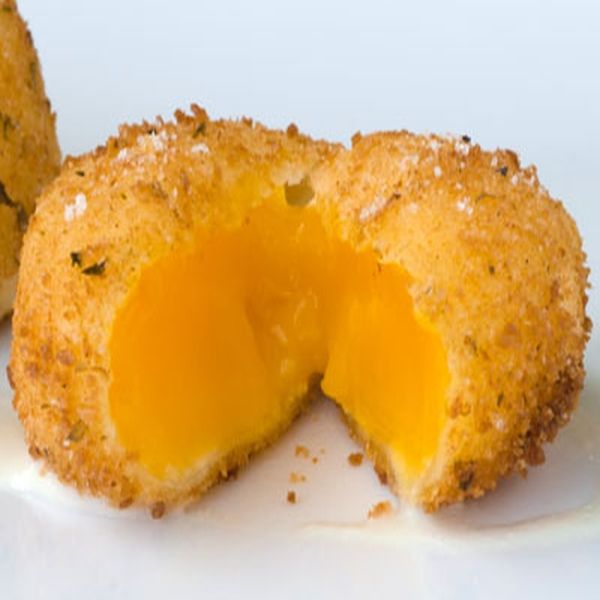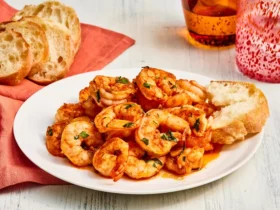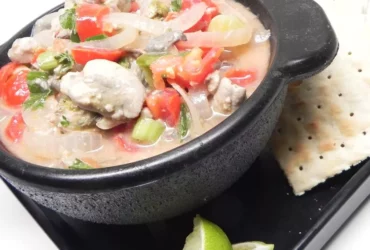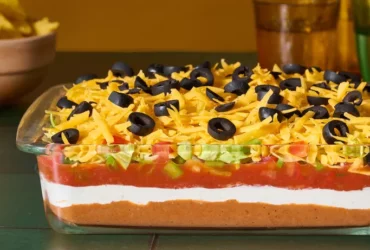Ingredients
Critical Components
The ingredients used for deep-frying sous vide egg yolks are crucial to achieving the perfect balance of flavors and textures.
Here are the key components needed for this recipe:
- Eggs: Fresh eggs with rich, creamy yolks are essential for this dish. It’s recommended to use high-quality, farm-fresh or pasture-raised eggs for optimal flavor and texture.
- Salt: A pinch of salt enhances the natural flavors of the egg yolks and helps balance out the sweetness of the oil. Use a flaky sea salt or kosher salt for best results.
- Black Pepper: Freshly ground black pepper adds depth and a subtle kick to the dish. Use a high-quality peppercorn that’s been freshly ground for the best flavor.
- Olive Oil: A neutral-tasting oil like olive or canola oil is ideal for deep-frying sous vide egg yolks. Make sure to heat the oil to the correct temperature (around 375°F/190°C) for crispy, golden-brown results.
- Water Bath: A water bath with precise temperature control (around 145°F/63°C) is necessary for cooking sous vide egg yolks. This ensures that the yolks cook evenly and without any risk of overcooking or undercooking.
Some additional ingredients, while not essential to the recipe, can enhance the overall experience:
- Citrus Zest: A sprinkle of citrus zest (such as lemon or orange) adds a bright, tangy flavor to the dish.
- Chopped Herbs: Chopped fresh herbs like parsley, chives, or cilantro can add a pop of color and freshness to the presentation.
- Ultimately, the key to successful deep-fried sous vide egg yolks lies in using high-quality ingredients, precise temperature control, and careful technique.
12 large egg yolks at room temperature
When it comes to making deep-fried sous vide egg yolks, having 12 large egg yolks at room temperature is crucial for achieving a perfect balance of texture and flavor.
The egg yolks should be removed from the refrigerator about an hour before starting to prepare them. This allows them to come to room temperature, which makes it easier to cook them evenly and prevents them from cooking too quickly on the outside before they are fully cooked inside.
Egg yolks at room temperature also help to ensure that the sous vide machine can cook them properly. If the egg yolks are cold, they may not heat up evenly or quickly enough, leading to undercooked or overcooked results.
It’s worth noting that using large egg yolks will give you a more substantial and decadent treat. The extra yolk size adds to the richness and creaminess of the dish, making it perfect for those who love a good indulgence.
The egg yolks should be washed gently under cold running water before cooking to remove any dirt or debris. This step is important to ensure that the egg yolks are clean and free from any contaminants that could affect their texture or flavor.
1 cup (240 ml) of water
The recipe requires one essential ingredient to be used as a liquid component, which is water. Specifically, it calls for 1 cup or approximately 240 milliliters of water.
Water is an integral part of the deep-frying process in this recipe. It’s crucial for maintaining the proper temperature of the oil, ensuring that the egg yolks are cooked evenly and to the desired doneness.
The amount of water specified in the recipe might seem negligible compared to the large volume of oil used for deep-frying. However, even small amounts of liquid can significantly impact the overall texture and consistency of the finished dish.
Using 1 cup (240 ml) of water also serves as a benchmark for achieving the perfect balance between moisture content in the egg yolks and the surrounding hot oil. This precise ratio is vital to prevent either undercooking or overcooking, which could alter the delicate texture and flavor of the final product.
1/4 cup (60 g) granulated sugar
The ingredients used in this recipe are straightforward and easily accessible. Here’s a breakdown of the required quantities for each ingredient:
Granulated Sugar:
Quantity: 1/4 cup (60 g)
Granulated sugar is a crucial component in this Deep-Fried Sous Vide Egg Yolks Recipe, serving as a key element in balancing the flavors and providing texture to the dish.
The granulated sugar is likely used to enhance the sweetness of the egg yolks during the deep-frying process. It’s also possible that it contributes to creating a crispy exterior on the fried egg yolk.
It’s worth noting that the quality or type of granulated sugar used in this recipe might not be as crucial as other ingredients, such as the freshness and quality of eggs, but still plays an important role in achieving the desired outcome.
Salt to taste
Salt to taste is an instruction often found in recipes, particularly those where a pinch or dash of salt adds flavor without overpowering other ingredients. In the context of the Deep-Fried Sous Vide Egg Yolks Recipe, Salt to taste implies that the amount of salt used will depend on individual preferences for the balance of flavors in each bite.
When using this instruction, it’s essential to consider the type and quality of salt being used. Different types of salt, such as sea salt or kosher salt, have varying textures and flavor profiles that may affect the overall taste experience. Additionally, some salt varieties are more concentrated than others, which can impact the amount needed for a particular dish.
In the Deep-Fried Sous Vide Egg Yolks Recipe, Salt to taste suggests using a high-quality salt that complements the rich flavors of the egg yolks and any accompanying ingredients without overpowering them. This approach allows diners or cooks to add just the right amount of salt to enhance their enjoyment of each bite.
The use of Salt to taste in cooking encourages experimentation and flexibility, as different amounts and types of salt can yield unique flavor experiences. By allowing individuals to adjust the seasoning to suit their preferences, this instruction fosters creativity and personalization in the culinary process.
Fat for Deep-Frying
The choice of fat for deep-frying is crucial when it comes to achieving the perfect texture and flavor for a dish like Deep-Fried Sous Vide Egg Yolks. The ideal fat should have a high smoke point, meaning it can be heated to a high temperature without breaking down or smoking.
Some common fats used for deep-frying include vegetable oils such as canola oil, corn oil, and safflower oil. These oils have a neutral flavor and a high smoke point, making them ideal for frying. However, they can be quite expensive.
Palm oil is another popular choice for deep-frying due to its affordability and high smoke point. It has a mild flavor and is often used in commercial kitchens. However, it may not be the best option for those looking for a more sustainable choice.
Cooking spray is also an option for deep-frying, but it’s generally considered a less healthy choice due to its high content of unhealthy fats.
When it comes to frying temperatures, it’s essential to heat the oil to the correct temperature to prevent the fat from breaking down. A good rule of thumb is to heat the oil to between 325°F and 375°F, depending on the type of fat being used.
In the case of Deep-Fried Sous Vide Egg Yolks, it’s best to use a neutral-tasting fat such as canola oil or corn oil. This will allow the natural flavors of the egg yolk to shine through.
Ultimately, the choice of fat for deep-frying will depend on personal preference and the type of dish being made. It’s essential to choose a high-quality fat that can withstand high temperatures without breaking down.
Vegetable oil with a high smoke point, such as peanut or avocado oil
When it comes to frying sous vide egg yolks, it’s essential to choose a high-quality vegetable oil that can withstand the heat without breaking down or smoking.
The key characteristic of this type of oil is its smoke point, which is the temperature at which the oil starts to break down and smoke. Oils with a high smoke point are ideal for deep-frying because they can be heated to high temperatures without burning or smoking.
Some popular options for high-smoke-point vegetable oils include peanut oil and avocado oil. Both of these oils have a mild, neutral flavor that won’t affect the taste of your fried egg yolks.
Peanut oil, in particular, is a popular choice for frying because it has a very high smoke point of around 450°F (232°C). This means you can heat the oil to a high temperature without worrying about it breaking down or smoking.
Avocado oil also has an impressively high smoke point of around 520°F (271°C), making it another excellent choice for frying sous vide egg yolks. The mild, buttery flavor of avocado oil adds a rich and creamy taste to your fried egg yolks.
It’s worth noting that while other oils like canola or grapeseed oil may have a slightly lower smoke point, they can still be used for frying. However, they may not produce the same level of crunch and texture as oils with an extremely high smoke point.
In summary, when it comes to choosing the best vegetable oil for deep-frying sous vide egg yolks, opt for a high-smoke-point oil like peanut or avocado oil. These oils will provide a crispy exterior and a creamy interior without breaking down or smoking at high temperatures.
Instructions
Sous Vide Egg Yolks Preparation
The process of preparing sous vide egg yolks for deep-frying involves several key steps, each crucial to achieving perfect results. To begin, you will need to procure a dozen large eggs and separate the egg whites from the egg yolks.
Gently place the yolks into a single layer at the bottom of a sous vide water bath container or a zip-top plastic bag submerged in ice. It is essential to keep them separated, as direct contact between the yolks can cause them to stick together.
Next, carefully pour hot water into the sous vide water bath until it reaches 145°F (63°C). Alternatively, you may use an immersion circulator to achieve the same temperature. Place the container with the egg yolks in the water bath and set a timer for exactly 60 minutes.
After the specified time has elapsed, immediately remove the sous vide egg yolks from the bath using a slotted spoon or tongs, taking care not to crack them. Rinse the yolks under cold running water to stop the cooking process.
Once cooled, gently peel the egg yolk shells off and pat them dry with paper towels. They are now ready for deep-frying according to your preferred recipe for deep-fried sous vide egg yolks.
Preheat the sous vide machine to 145°F (63°C).
To begin preparing this indulgent treat, it’s essential to first understand and follow the proper instructions for using a sous vide machine. The initial step involves preheating the device to a precise temperature of 145°F (63°C). This process is critical in ensuring that the egg yolks are cooked to the desired doneness while maintaining their creamy texture.
The key to successful sous vide cooking lies in accurately controlling the water temperature, which directly affects the final result. In this case, heating the machine to 145°F (63°C) allows for a gentle and even cooking process that prevents overcooking or undercooking of the egg yolks.
Once the machine has reached the desired temperature, carefully place a few eggs into the sous vide water bath, making sure they are fully submerged. Seal the bag to prevent any air from entering during the cooking process, and ensure that it is tightly closed to maintain an even temperature distribution.
The sous vide machine will then work its magic by circulate the heated water at a precise temperature around the egg yolks, ensuring uniform doneness and texture. It’s worth noting that using high-quality eggs is crucial for achieving the best results in this recipe.
Place the egg yolks in individual cups or bags.
To create the perfect Deep-Fried Sous Vide Egg Yolks, it’s crucial to start with a clear understanding of the preparation process and adhere to precise instructions.
Step 1: Preparing the Egg Yolks
Begin by separating the egg yolks from their albumen and placing them in individual cups or bags. This step is essential for maintaining cleanliness, making it easier to handle each yolk, and preventing cross-contamination.
Key Considerations
- Choose eggs that are fresh from the refrigerator to minimize the risk of contamination.
- Separate the egg yolks carefully, as any shells can introduce bacteria and affect the dish’s quality.
Next, cover each yolk with plastic wrap or a secure lid on the cup/bag. This will prevent any external substances from affecting the egg and also help maintain its freshness during storage.
Step 2: Cooking the Egg Yolks Sous Vide
Place the covered cups/bags in a sous vide machine set to 145°F (63°C). This temperature is crucial for cooking the egg yolks without overcooking or undercooking them. The egg yolks will cook evenly throughout, yielding a rich and creamy center.
Tips
- Set the timer according to your desired level of doneness for the egg yolk. For example, cooking time can range from 45 minutes to an hour for runny yolks or longer for firmer textures.
Once the desired temperature is reached and cooking time has elapsed, carefully remove the cups/bags from the water bath. Be cautious not to open the containers immediately as you’ll want the eggs to slowly release any pressure built up during cooking.
Step 3: Deep-Frying the Egg Yolks
To add a crispy exterior to your sous vide egg yolks, heat a deep fryer or large saucepan with at least two inches of oil (such as vegetable or canola oil) to 325°F (165°C). Using tongs or slotted spoon, gently place the cooked yolk in the hot oil and cook until golden brown. This process typically takes around one minute on each side.
Final Touches
- Using a slotted spoon, carefully remove the fried egg yolk from the oil and place it onto paper towels to drain excess fat.
- Serve immediately for optimal enjoyment!
This method produces Deep-Fried Sous Vide Egg Yolks with an exceptional texture contrast – crispy exterior and rich interior. Follow these instructions carefully, ensuring accuracy at each stage of preparation to achieve this mouth-watering dish.
Seal the eggs and cook for 4560 minutes.
The key to successfully making deep-fried sous vide egg yolks lies in carefully following a set of instructions. Firstly, it’s crucial to seal each egg yolk individually using a sous vide machine or a vacuum sealer.
Next, cook the sealed egg yolks for an extended period, specifically 4560 minutes. This prolonged cooking time is essential to achieving the desired creamy and runny texture of the egg yolks when they are deep-fried later on.
It’s worth noting that this step is often referred to as “curing” the egg yolks, where they’re slowly cooked in a water bath at a precise temperature. This process helps to break down the proteins and fats within the egg yolks, creating a silky and smooth texture when fried.
When you remove the egg yolks from the sous vide machine or water bath after 4560 minutes, be sure to let them cool completely before proceeding with frying. The eggs can then be coated in a light batter and deep-fried until golden brown for added crunch.
To add an extra layer of flavor, consider adding herbs, spices, or other seasonings to the egg yolks during the curing process. This will infuse your deep-fried egg yolks with unique flavors that complement their rich, creamy texture perfectly.
Shock the egg yolks in an ice bath to stop the cooking process.
To successfully execute this unique dish, it’s essential to understand the importance of cooling the egg yolks quickly after cooking.
The process involves shocking the egg yolks in an ice bath to stop the cooking process and prevent overcooking.
Why Shock the Egg Yolks?
This step is crucial because egg yolks continue to cook even after they are removed from the water bath or deep fryer.
If left unattended, the yolks can become overcooked, leading to a rubbery texture and an unpleasant flavor.
Shocking the egg yolks in an ice bath immediately after cooking halts the cooking process and helps preserve their creamy texture and rich flavor.
How to Shock the Egg Yolks
- Pick a suitable container: Choose a shallow metal pan or a heat-proof bowl that can accommodate the egg yolks in a single layer. This will ensure even cooling.
- Fill with ice: Fill the container with ice, making sure to cover the bottom of the pan completely. You can also add some cold water to the ice if needed.
- Add the egg yolks: Gently place the cooked egg yolks into the ice bath. Make sure not to crack them or break their shape.
- Stir occasionally: Use a spatula or spoon to gently stir the egg yolks every 30 seconds or so, ensuring they cool evenly and quickly.
The entire process should take about 5-7 minutes, depending on the size of your egg yolks and the temperature of your ice bath. Once the egg yolks have cooled, you can remove them from the ice bath and use them in your Deep-Fried Sous Vide Egg Yolks Recipe.
Deep-Frying Egg Yolks
Heating Oil and Deep Frying
The art of deep-frying egg yolks has gained significant attention in recent years, particularly with the rise of sous vide technology.
This technique involves cooking egg yolks to a precise temperature using a water bath, and then deep-frying them for added crunch and flavor.
Why Deep-Fry Egg Yolks?
Deep-frying egg yolks adds a satisfying texture and enhances the richness of the dish.
- Texture contrast: The crispy exterior of the fried yolk provides an appealing contrast to the soft, creamy interior.
- Flavor enhancement: The Maillard reaction that occurs during frying contributes to a deeper, more complex flavor profile.
- Aesthetic appeal: Deep-fried egg yolks can be visually stunning when garnished with herbs or other toppings.
Choosing the Right Heating Oil for Deep Frying
The type of oil used for deep frying is crucial, as it affects the flavor and texture of the fried yolk.
- Peanut oil: A popular choice for its mild flavor and high smoke point, making it ideal for delicate foods like egg yolks.
- Avocado oil: A healthy option with a high smoke point, offering a buttery, nutty flavor that complements the richness of the yolk.
Deep-Frying in General
For deep frying to be successful, it’s essential to maintain precise control over temperature and timing.
- Temperature range: Frying temperatures typically range from 325°F (165°C) for delicate foods to 375°F (190°C) for more robust ingredients.
- Timing is everything: The optimal frying time will depend on the size and thickness of the yolk, as well as the type of oil used.
The Science Behind Sous Vide Egg Yolks and Deep-Frying
Sous vide cooking ensures that egg yolks are cooked to a precise temperature, which is then enhanced by the Maillard reaction during deep frying.
- Temperature control: Sous vide technology allows for precise temperature control, ensuring that the yolk reaches a safe minimum internal temperature of 160°F (71°C).
- Maillard reaction: The high heat and oil used in deep frying initiate a chemical reaction between amino acids and reducing sugars, contributing to the formation of new flavor compounds.
Putting it all Together: Deep-Fried Sous Vide Egg Yolks Recipe
This recipe combines the precise temperature control of sous vide technology with the added crunch and flavor of deep-frying for a unique and impressive dish.
- Cook sous vide egg yolks: Set the sous vide machine to 160°F (71°C) and cook the egg yolks for 1-2 hours, depending on desired doneness.
- Heat oil for deep-frying: Heat peanut or avocado oil in a deep frying pan to 350°F (175°C).
- Deep-fry egg yolks: Gently place the cooked egg yolks into the hot oil and fry for 10-15 seconds on each side, or until golden brown.
- Drain and serve: Remove the fried yolk from the oil with a slotted spoon and drain on paper towels. Serve immediately.
This recipe offers a unique combination of flavors and textures, showcasing the potential for sous vide technology to revolutionize home cooking.
Heat the vegetable oil to 375°F (190°C) in a deep frying pan.
- To begin, let’s start with preparing the egg yolks for deep-frying.
- Freshly cooked sous vide egg yolks are the perfect candidate for this recipe. You can cook them to a temperature of 145°F (63°C) using a sous vide machine before proceeding.
- Once you have your perfectly cooked sous vide egg yolk, it’s time to prepare them for deep-frying.
- Rinse the egg yolks under cold water, then gently pat them dry with paper towels. This step is crucial in removing any excess moisture that may hinder the deep-frying process.
- Next, heat a sufficient amount of vegetable oil to 375°F (190°C) in a deep frying pan or a deep fryer. It’s essential to use a thermometer to monitor the temperature accurately.
- Using two forks, carefully lift each egg yolk and gently lower it into the hot oil. Be cautious not to overcrowd the pan as this can affect the even cooking of the egg yolks.
- Fry the sous vide egg yolks for about 30 seconds on each side or until they are golden brown in color. The key is to achieve a delicate balance between crispy exterior and runny interior.
- Using a slotted spoon, carefully remove the fried egg yolk from the oil and drain any excess oil on paper towels.
- The result will be an impossibly creamy and richly textured deep-fried egg yolk. It’s best to serve it immediately while still warm.
Carefully remove the egg yolks from the ice bath and place them in the hot oil.
The art of deep-frying egg yolks may seem daunting, but with the right technique and equipment, it can be a game-changer for food enthusiasts. In this recipe, we’ll be using sous vide to cook the egg yolks to perfection before finishing them off in hot oil.
Preparing the Egg Yolks
To start, crack 4-6 eggs into a bowl and carefully remove the egg yolks from their whites. The sous vide machine will be used to cook these yolks to the perfect doneness, so it’s essential that they are removed gently to avoid any damage.
Temperature Control with Sous Vide
Set your sous vide machine to 63°C (145°F), and then seal each egg yolk in a separate bag. This precise temperature is crucial for achieving the right texture when deep-frying the yolks later on.
Cooking Egg Yolks in Sous Vide
Place the sealed bags into the sous vide water bath, making sure they are fully submerged. The egg yolks will cook to a silky and creamy state in about 45 minutes. Keep an eye on them, as cooking time may vary depending on your desired level of doneness.
Deep-Frying Egg Yolks
After the egg yolks have finished cooking, carefully remove them from the ice bath and place them in the hot oil. You can use a thermometer to ensure the oil has reached 180°C (350°F), which is perfect for frying. Use a slotted spoon to gently drop the egg yolks into the hot oil.
Double-Frying Method
To achieve the signature crunchy outside and creamy inside, follow this two-step process:
- Fry the egg yolks for about 20 seconds or until they’re golden brown. Remove them from the hot oil with a slotted spoon and place them back into the ice bath to stop the cooking process.
- Immediately reheat the hot oil to 180°C (350°F) and fry the egg yolks again for an additional 10-15 seconds or until they’re crispy on the outside. Be careful not to burn the egg yolks during this second frying step.
Serving Deep-Fried Sous Vide Egg Yolks
Remove the deep-fried egg yolks from the oil and place them on a paper towel-lined plate to drain any excess oil. Serve immediately, garnished with salt and pepper, or your choice of herbs for added flavor.
Tips and Variations
For an extra kick, add some spicy hot sauce to the egg yolks before deep-frying them. You can also use different seasonings or spices in the hot oil for unique flavor combinations.
This recipe is sure to become a favorite among adventurous foodies and fans of creative twists on classic dishes!
Fry for 3045 seconds or until the exterior is golden brown.
Deep-frying egg yolks is a unique and fascinating culinary technique that can add an exciting texture and flavor to various dishes, particularly when paired with sous vide eggs.
In this recipe, we will focus on deep-frying sous vide egg yolks, which have been cooked to the perfect doneness before being coated in a light batter and fried until golden brown. This process allows for precise control over the texture and temperature of the egg yolks.
The key to successful deep-fried egg yolks is achieving the right balance between the soft, creamy interior and the crunchy, caramelized exterior. To achieve this, it’s essential to cook the sous vide eggs to an internal temperature of at least 145°F (63°C), which will ensure that they are cooked through but still retain a slightly runny texture.
Once you have your perfectly cooked sous vide egg yolks, it’s time to prepare them for frying. Start by carefully cracking each yolk into a shallow dish or bowl. Next, sprinkle a pinch of salt over the top of each yolk to help balance out the flavors and create a delicate crust during cooking.
Now it’s time to mix together your deep-frying batter. Combine 1 cup of all-purpose flour, 1/2 cup of cornstarch, and 1/4 teaspoon of salt in a separate bowl. Gradually add in 1/2 cup of ice-cold water while continuously whisking the mixture until it reaches a smooth, thick consistency.
Once your batter is ready, carefully dip each egg yolk into the mixture, coating it evenly and gently shaking off any excess before placing it on a plate or tray lined with parchment paper. You can also coat multiple egg yolks at once by using a slotted spoon to submerge them in the batter.
Heat about 1-2 inches (2.5-5 cm) of your chosen oil (such as vegetable, canola, or peanut oil) in a deep frying pan over medium-high heat until it reaches a temperature of around 375°F (190°C). Once the oil is hot and shimmering, carefully place each coated egg yolk into the oil using a slotted spoon.
Fry for exactly 3045 seconds (which translates to approximately 51 minutes) or until the exterior turns golden brown. Keep in mind that deep-frying times can vary depending on your heat source and equipment, so be prepared to adjust your cooking time accordingly.
As soon as the egg yolk is done frying, carefully remove it from the oil using a slotted spoon and place it on a plate or tray lined with paper towels to drain any excess oil. Repeat this process for all of your coated egg yolks.
Your deep-fried sous vide egg yolks are now ready to be enjoyed as a side dish, added to salads, or even used as a garnish for various cocktails and desserts. Be sure to serve them immediately while they’re still warm and crunchy.
- Best Lusha Alternatives for 2025 - April 22, 2025
- Best Overloop Alternatives for 2025 - April 22, 2025
- Best 6sense Alternatives for 2025 - April 22, 2025















